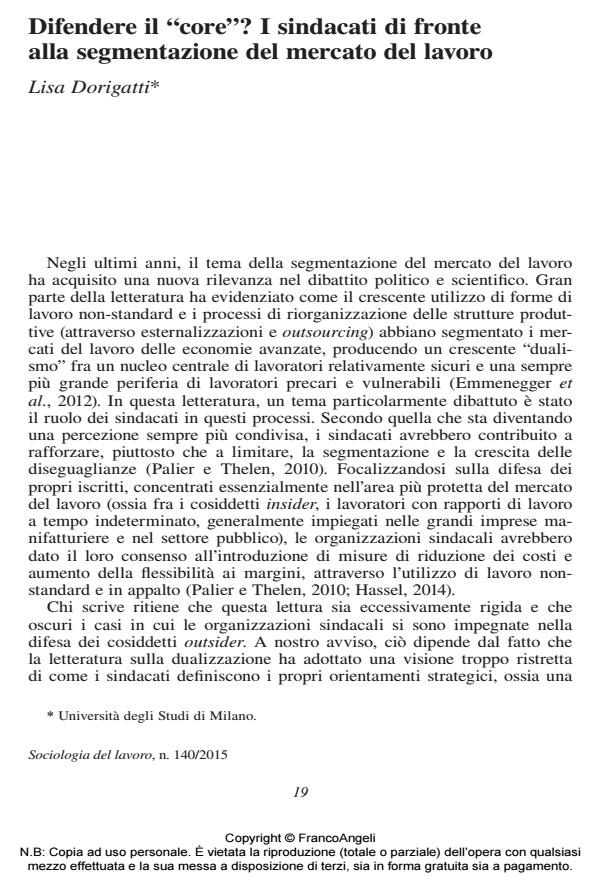Defending the "core"? Trade unions confronted with labour market dualisation
Journal title SOCIOLOGIA DEL LAVORO
Author/s Lisa Dorigatti
Publishing Year 2015 Issue 2015/140
Language Italian Pages 14 P. 19-32 File size 97 KB
DOI 10.3280/SL2015-140002
DOI is like a bar code for intellectual property: to have more infomation
click here
Below, you can see the article first page
If you want to buy this article in PDF format, you can do it, following the instructions to buy download credits

FrancoAngeli is member of Publishers International Linking Association, Inc (PILA), a not-for-profit association which run the CrossRef service enabling links to and from online scholarly content.
Over the last three decades, the issue of labour market segmentation has acquired a renewed significance in the political and scientific debate. Within this debate, a particularly discussed topic has been the role of trade unions in segmentation processes. According to the dualisation literature, trade unions have contributed to strengthen, rather than limiting, segmentation and the growth of inequalities on the labour market, since they are focused on the defense of their members, mainly concentrated in the most protected labor market segments. Through the analysis of the strategies adopted by German unions of the chemical and metalworking sectors towards outsourcing and nonstandard forms of employment, this study challenges this view. We will show that trade unions do not necessarily exclude outsiders. This is because the defense of their members is just one of the possible reasons that define trade unions’ strategies. In addition, we show how the same willingness to defend the interests of their members does not lead necessarily to the exclusion of more peripheral workers, since the growth of the latter often puts the former under strain. To represent more vulnerable workers becomes, therefore, a need for trade unions in order to defend also more stable workers.
Keywords: Segmentation, insider/outsider, trade union strategies, Germany
- Stratificazione, nocività e lavoro immigrato. il caso del distretto conciario della Valle del Chiampo Davide Marchi, in ECONOMIA E SOCIETÀ REGIONALE 1/2024 pp.61
DOI: 10.3280/ES2024-001005 - Diversity Management Policies for the Inclusion of LGBT People into the Labour Market: The Case of Naples Massimiliano Agovino, Fabio Corbisiero, in Papers in Applied Geography /2021 pp.50
DOI: 10.1080/23754931.2020.1815236
Lisa Dorigatti, Difendere il "core"? I sindacati di fronte alla segmentazione del mercato del lavoro in "SOCIOLOGIA DEL LAVORO " 140/2015, pp 19-32, DOI: 10.3280/SL2015-140002